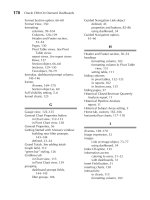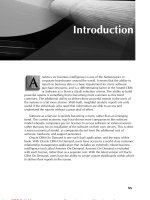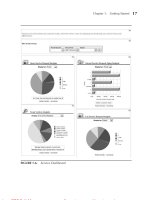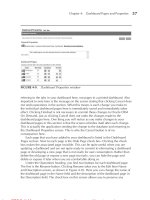Car Test -- Hydrogen On Demand (Pure hydrogen, not HHO) Can pure hydrogen (H2) replace HHO to increase MPG? pdf
Bạn đang xem bản rút gọn của tài liệu. Xem và tải ngay bản đầy đủ của tài liệu tại đây (597.59 KB, 34 trang )
Page 1
Phillips Company
CT.p65
Car Test Hydrogen On Demand
(Pure hydrogen, not HHO)
Can pure hydrogen (H2) replace HHO to increase MPG?
Updated : 11/2012
By: Phillips Company
Email: , Tel. 580 746 2430
See Car Test Results page 13
Page 2
Phillips Company
CT.p65
Contents
Car Test Hydrogen On Demand 1
Section 1 Hydrogen Cell Initial Results, 2011. 4
Can pure hydrogen (H2) replace HHO to increase MPG? 5
Technology comparison; HHO system and CC-HOD H2 system 5
Aluminum hydroxide, aluminum oxide and recycling 6
The need for pure hydrogen (this invention) 7
Problem and solution 7
The present invention for hydrogen production improves the state of the art 7
Catalytic Carbon (CC) is intended for the high-production-rate, large-volume pro-
duction of hydrogen. 8
Chemical reactions 8
The present invention uses simple and well-known chemical reactions 8
High rates of hydrogen production are possible 9
Hydrogen production rates: Up to 4 LPM in small reaction chambers 9
Hydrogen production rates: Up to 35 gallons/minute in large reaction chambers.
10
By-products are fully recoverable using existing commercial methods for producing
aluminum metal. 10
Fuel: The use of lower-cost, lower-purity aluminum 11
Fuel: The use of water from almost any source is a novel aspect of the present in-
vention. 11
The use of salt water makes the present invention suitable for marine applications
and as an energy source for coastal areas 11
Catalytic Carbon (CC) can be used with the most desired materials to produce
hydrogen 12
Safety: Catalytic Carbon (CC) can be used with the world’s safest materials to
produce hydrogen. 12
First pure-hydrogen road test using CC 13
Page 3
Phillips Company
CT.p65
First test run: 37 MPG 15
The government says this Buick should get 26 MPG (highway
driving) 16
Analysis: 32% increase in gas mileage 16
Engineering design concepts 17
Summary 17
Section 2 Hydrogen Cell Design and Fabrica-
tion, 2012 18
2012 Prototype cell design update 19
Installation of hydrogen system 30
Problems and comments 31
Operation of the hydrogen system 32
We used both CC/Al fuel and CA fuel 33
How to evaluate this new H2 system 34
Page 4
Phillips Company
CT.p65
Section 1
Hydrogen Cell Initial
Results, 2011
Page 5
Phillips Company
CT.p65
Technology comparison; HHO system and CC-HOD H2 system
Can pure hydrogen (H2) replace HHO to increase MPG?
Page 6
Phillips Company
CT.p65
Aluminum hydroxide, aluminum oxide and recycling
The following online article explains how bauxite (aluminum oxide) is mined, refined
and smelted to produce aluminum.
/>The by-products from the CC method of producing hydrogen have a special
characteristic they are identical to the MOST PURE form of refined bauxite.
Page 7
Phillips Company
CT.p65
The need for pure hydrogen (this invention)
A hydrogen-based economy is the only long-term, environmentally-benign energy
alternative for sustainable growth. The increasing demand for hydrogen arises from the
impending paradigm shift to a hydrogen-based energy economy. This change will
become needed as the worldwide need for more electricity increases, greenhouse gas
emission controls tighten, and fossil fuel reserves wane.
Problem and solution
The future increasing need for hydrogen fuel has created a problem: the problem is the
lack of a hydrogen-supply infrastructure that is necessary for the proliferation of the use
of hydrogen. The present invention provides a simple solution, in that hydrogen on
demand (HOD) is available at any desired high production rate. This makes it
unnecessary to store hydrogen in a pressurized tank for release later at a high rate.
The present invention makes it possible to control and sustain the continuous production
of hydrogen with no requirement for any external energy. The controlled, sustained
production of hydrogen has been achieved in our laboratory so long as water, aluminum
and Catalytic Carbon (CC) are provided to the hydrogen-production cell.
The present invention for hydrogen production improves the state of the art
The common method to recover hydrogen from water is to pass electric current through
water and to reverse the oxygen-hydrogen combination reaction, i.e. water electrolysis.
Another method involves extraction of hydrogen from fossil fuels, for example from
natural gas or methanol. This method is complex and always results in residues, such as
carbon dioxide. And, there is worldwide limit to the fossil fuel available for use in the
future. In these reforming methods the resulting hydrogen must be somehow stored and
delivered to the user, unless the hydrogen generation is performed “on-board,” close to
the point of use. The safe, reliable, low-cost hydrogen storage and delivery is currently
one of the bottlenecks of the hydrogen-based economy. The present invention addresses
this problem through safe, “on-board/on-demand” production of hydrogen close to the
user systems, using simple, safe and pollution-free metal oxidation reacting with water
and Catalytic Carbon (CC).
Page 8
Phillips Company
CT.p65
Catalytic Carbon (CC) is intended for the high-production-rate, large-volume
production of hydrogen.
Although about 20% of air is oxygen, there is no easily-accessible, safe source of
hydrogen available. The current invention addresses and solves this problem. CC-HOD
relates to a novel method of generating hydrogen from water. Water consists of two
elements: oxygen and hydrogen. A relatively large amount of energy is released when
these two elements react to form water. This energy may be captured and may be used as
a heat source, a combustion fuel, or it can be efficiently converted to electricity in fuel
cells. One novel aspect of CC-HOD is that the high production rate of hydrogen makes
previously-impossible applications technically feasible for the first time, especially for
high-energy-consumption applications. Because of the straight-forward scale-up of the
production rate of hydrogen using the present invention, the use of Catalytic Carbon
(CC) makes it feasible to use high-production-rate hydrogen as fuel or as a fuel
supplement for commercial power plants, trans-oceanic ships and remote locations,
including third-world population centers and outposts on other planets so long as water,
aluminum and Catalytic Carbon (CC) are provided to the hydrogen-production cell. In
the later potential application, an important advantage of this invention is that only water
and water vapor (nothing else) is released when oxygen and hydrogen react using
Catalytic Carbon (CC). Consequently, the hydrogen-oxygen reaction is potentially a
pollution-free source of energy.
Chemical reactions
The present invention uses simple and well-known chemical reactions
2Al + 6H
2
O + CC => CC + 2Al(OH)
3
+ 3H
2
where Aluminum and water are fuels and
the only by-product is aluminum hydroxide Al(OH)
3
. In this reaction, CC is a catalyst
which is not consumed or chemically transformed in the reaction.
The same reaction can be written as 2Al + 3H
2
O + CC => CC + Al
2
O
3
+ 3H
2
where
Aluminum and water are fuels and the only by-product is aluminum oxide, Al
2
O
3
. In
this reaction, CC is a catalyst which is not consumed or chemically transformed in the
reaction.
Page 9
Phillips Company
CT.p65
Aluminium hydroxide, Al(OH)
3
is found in nature as the mineral gibbsite (also known as
hydrargillite) and its three polymorph forms: bayerite, doyleite and nordstrandite. [Ref
Wikipedia]
Closely related to aluminium hydroxide is aluminium oxide, Al
2
O
3
, differing only by loss
of water. These compounds together are the major components of the aluminium ore
bauxite. [Ref Wikipedia]
Aluminum, a fuel used for producing hydrogen, comes from bauxite. Bauxite is an
aluminium ore and is the main source of aluminium. This form of rocky ore consists
mostly of the minerals gibbsite Al(OH)
3
, boehmite AlO(OH), and AlO(OH), in a mixture
with the two iron oxides goethite and hematite, the clay mineral kaolinite, and small
amounts of anatase TiO
2
. [Ref Wikipedia]
High rates of hydrogen production are possible
Most methods of producing hydrogen (electrolysis, thermo-forming) produce hydrogen
at low rates when measured in units of volume per minute (LPM) per gram aluminum
per joule of required energy, or LPM/gm per joule. Using this benchmark for production
rate evaluation quickly leads to the conclusion that electrolysis and thermo-reforming are
poor performers simply because of the energy required to drive the processes.
Our invention is much better than electrolysis or thermo-reforming processes (for
hydrogen production). This is because our invention uses a process that only needs
external heat to start the reaction, usually in the temperature range of 150F to 190F.
Once started, the reaction, because it is fundamentally exothermic, provides enough heat
to sustain the reaction. The only external energy required is for cooling, if needed to
limit the production rate to some desired target value.
Hydrogen production rates: Up to 4 LPM in small reaction chambers.
In our laboratory we carried out more than 50 experimental runs in which we obtained
hydrogen production rates of 400 mL/minute to 4 LPM with a hydrogen cell charged
with 10 to 40 gm of powdered aluminum. These experimental cells had reaction-
chamber volumes ranging from 100 mL to 1 liter, made from plastic bottles and glass
containers. Higher rates were demonstrated in our laboratory and we believe rates
exceeding 100 LPM can be easily achieved using larger cells in non-laboratory
(industrial) conditions because the scale-up of the present invention has no known
Page 10
Phillips Company
CT.p65
fundamental barriers.
The controlled, sustained production of hydrogen was achieved in our laboratory so long
as water, aluminum and Catalytic Carbon (CC) was provided to the hydrogen-production
cell.
Hydrogen production rates: Up to 35 gallons/minute in large reaction chambers.
130 LPM of hydrogen was produced during scale-up experiments. For more
information, please see
www.PhillipsCompany.4T.com/CA.pdf
By-products are fully recoverable using existing commercial methods for producing
aluminum metal.
The by-products from our hydrogen-production method are desirable because they are
pure, and contain no contaminants including bauxite, gibbsite, boehmite, goethite,
hematite, kaolinite, and TiO
2
. We reason that the large volume of by-products of our
invention,
pure Al(OH)
3
and pure Al
2
O
3
, will be 100% recycled to produce more
aluminum metal. Recycling of aluminum hydroxide and aluminum oxide makes the
present invention economically viable for large-volume hydrogen generation. An
excellent discussion of the process for primary aluminum production, as well as world-
wide values for the energy requirements for aluminum smelting, can be found on a web
site produced by the International Aluminium Institute (www.world-aluminium.org).
For more information, please see
www.PhillipsCompany.4T.com/AHA.pdf
Aluminum refining from aluminum-bearing bauxite ore uses the Bayer process
chemistry which forms a hydrate which is essentially the same as the reaction product in
the proposed aluminum-water reactions described above. [Ref DOE paper, 2010] The
hydrate is then calcined to remove the water to form alumina. The alumina is
electrolytically reduced into metallic aluminum at about 900
o
C using the Hall-Heroult
Process, producing a metal with 99.7% purity.
Page 11
Phillips Company
CT.p65
Fuel: The use of lower-cost, lower-purity aluminum
For a given mass of aluminum in the reaction, the hydrogen production rate is
approximately proportional to the surface area of the aluminum metal. The aluminum
used in our experiments was powdered aluminum. The higher surface-to-volume ratio of
powdered fuel makes it suitable for higher-rate hydrogen production. More course fuel,
in the form of pellets or granules can be used, but at a lower production rate of hydrogen
for any given amount of aluminum.
The present invention uses aluminum and water for fuel. The process latitude for this
process is excellent. The use of pure aluminum is not required, making possible the use
of lower cost, less-pure aluminum in our hydrogen-production process.
Fuel: The use of water from almost any source is a novel aspect of the present
invention.
The present invention uses aluminum and water for fuel. The use of pure water is not
required. Therefore it is not necessary to use expensive water such as distilled water or
de-ionized water for the production of hydrogen. This has been proven in our laboratory
using tap water, dirty water, high-calcium water, salt water, alkaline water, and acidic
water. All water samples used in our laboratory experiments have worked well during
our work to produce hydrogen. Although not required, some forms of water, including
salt water and alkaline water, perform somewhat better in our process than more pure
forms of water such as deionized water. When producing hydrogen with the present
invention, more design latitude and freedom is available to the hardware design engineer
in the selection of materials, water and water ingredients to minimize corrosion of the
materials used in the construction of the cell and associated parts of the system. The
excellent process latitude for water purity makes it possible to use a wider range of
materials with the probable result of cost reduction for equipment designed for use with
the present invention.
The use of salt water makes the present invention suitable for marine applications
and as an energy source for coastal areas.
Page 12
Phillips Company
CT.p65
As noted above, salt water can be used to produce hydrogen using the present invention.
This means that the present invention is naturally suited for use in producing fuel in all
parts of the world where human settlements are located near any seashore, including
remote islands. Many island nations, including Japan, can use the present invention to
decrease fuel costs and reduce or eliminate the need for tanker-ship import of fossil
fuels. Other island groups, including Hawaii, can improve the local economy by
reducing fuel costs using the present invention to reduce or eliminate the need for
tanker-ship import of fossil fuels.
Catalytic Carbon (CC) can be used with the most desired materials to produce
hydrogen.
There are only a few materials that can produce abundant hydrogen and these include
hydrocarbons and water. Of these, the only pollution free source of hydrogen is water.
One of the problems that must be addressed before the new hydrogen economy replaces
the current “oil/gas/coal/nuclear” economy, is finding a safe, environmentally benign and
cost-effective method of generation of hydrogen at any desired rate. The solution of this
problem is the primary focus of the present invention.
Safety: Catalytic Carbon (CC) can be used with the world’s safest materials to
produce hydrogen.
Carbon, water, aluminum, aluminum oxide and aluminum hydroxide are the safest
materials known to humanity (e.g. they are commonly used in foods, drugs, cosmetics
and other safe to use/handle products). The present invention works well using a wide
range of pH, and this includes neutral pH values in the range of 6 to 8. The use of
neutral pH chemistry eliminates the threat of acid burns or alkali burns to human skin
and eyes. Alkali-burn damage to the eyes, due to an accidental splash, is a safety hazard
when using electrolysis to produce hydrogen. Electrolysis fundamentally requires the
use of a strong electrolyte to increase the electrical conductivity of the water, whereas
the present invention produces hydrogen chemically, without the use of electrolysis and
without the requirement for electrolyte additives. The present invention, based on CC,
promises to be safe and manageable by simple means.
Page 13
Phillips Company
CT.p65
First pure-hydrogen road test using CC
2004 Buick Park Avenue
Fill plug and inspection port
Hydrogen output
Bubbler (called the “dirty
bubbler”)
Water gravity flow
Fill cap and inspection port
Hydrogen from cell, up to the
bubbler
Glow plug (startup heater)
Mounting bracket
Page 14
Phillips Company
CT.p65
Fill cap
Hydrogen input from cell
Hydrogen output to solenoid valves
(switches to engine or to vent)
Tube from “clean bubbler” to flow rate
meter
Clean bubbler
Flow rate meter
Instrumention is mounted on the rear view
mirror. In a commercial system this would
not be needed or included. This apparatus
is to give a visual indication of hydrogen
flow rate during road tests.
Page 15
Phillips Company
CT.p65
37 MPG
35.7 MPG
33.3 MPG
35.9 MPG
T = 0 minutes: Cell charged with 2 HTsp
Al powder. and heating element was
switched on. Heatup and hydrogen flow
required about 5 minutes.
T = 5 minutes: Buick engine was started
with hydrogen flowing. The EFI computer
“trained” open loop to closed loop with
hydrogen flowing. Speed = 55 MPH. Max
hydrogen flow rate estimated = 0.3 LPM.
T = 10 minutes: Flow rate decreased with
time, as the small-particle aluminum was
consumed (along with some water).
Solenoid valve was switched so that
hydrogen was vented (not piped to engine).
Mileage dropped 6.7%; from 35.7 MPG to
33.3 MPG. Even so, this is a higher gas
mileage than usual for this car.
After driving 5 miles, the hydrogen flow was
switched to VENT. On the return trip, the
mileage was higher than usual WITHOUT
any hydrogen flowing to the engine. Why?
Could the EFI computer have been trained
on hydrogen in a way that it somehow chose
a “set point” that is leaner than usual, thereby
causing the gas mileage to be greater than
usual even when hydrogen was no longer
supplied to the engine?
First test run: 37 MPG
First test run on 7/29/2011: 37 MPG on a Buick that usually gets a MAXIMUM of 30
MPG, even on long road trips. Typical highway gas mileage for this car is about 26 to 28
MPG.
Page 16
Phillips Company
CT.p65
/>The government says this Buick should get 26 MPG (highway
driving)
Analysis: 32% increase in gas mileage
My experience with this Buick is that it gets better gas mileage (26 to 28 MPG) under
normal highway driving conditions; unleaded fuel. To be conservative, let’s assume that
the normal, no-hydrogen highway gas mileage is 28 MPG for this car.
The first road test WITH hydrogen showed a gas mileage of 37 MPG with a hydrogen
flow rate of 0.3 LPM (estimated). This is considered a low flow rate, because
independent calculations suggest that best performance at 60 MPH with hydrogen might
require about 3 LPM (10 times greater than the flow rate for this first test).
Using these numbers, an ESTIMATED improvement in gas mileage for this first test was
(37 - 28) / 28 =
32% increase in gas mileage
Wow!
Page 17
Phillips Company
CT.p65
Engineering design concepts.
1. We need a way to deliver the fuel (water and aluminum) to the cell in a variable and
controlled way. Rough calculations indicate that the right delivery rate would be about 1
mL per minute to 2 mL per minute of thick liquid. Variation over this range would be
like varying the rate of diesel to the engine. The Al/water mix might be somewhat thick
something like syrup. This will be the “feed” to the hydrogen cell.
2. We need a good way to control the temperature of the cell.
A. STARTUP: Heat the cell quickly, up to about 180F and start the "feed" of
fuel to the cell.
B. SUSTAINED OPERATION ON THE ROAD: Keep the cell cool as the
reaction produces heat (this is called an exothermic chemical reaction).
C. SHUTDOWN: Cool the cell down and stop the "feed" of fuel to the cell.
This is very much like how a normal diesel engine works. It uses a glow plug to quickly
heat the cylinder; then fuel is fed to the combustion chamber at a rate that varies
depending on changing speed and power required; and temp control (cooling) is
provided by circulating water driven by the water pump.
Summary
We have discovered an amazing new method for producing hydrogen on demand. Pure
hydrogen (no oxygen) at any flow rate, 1 LPM, 2 LPM to 10 LPM. No EFIE or EFII
required. No oxygen sensor or EFI changes needed. Current required = 0 Amperes. No
electrolyte. No corrosion of anode or cathode (none at all!). pH is neutral. Chemistry is
safe.
Who are we?
We are not an automotive products company; we are a pharmaceutical company. Our web site is:
www.PhillipsCompany.4T.com/HYDROGEN.html
We just happened to have the catalytic chemistry capability needed for splitting water with very little
energy required. So, we need a strategic alliance who is in the automotive products business.
Page 18
Phillips Company
CT.p65
Section 2
Hydrogen Cell Design
and Fabrication, 2012
Page 19
Phillips Company
CT.p65
2012 Prototype cell design update
The following information is an update, giving information that has been learned and
demonstrated in our R&D project during 2012.
The Buick test vehicle has had many cell designs installed for evaluation. The “shelf”
on the front bumper makes system change-out easy. The grill has been removed for the
same reason to make system change-out and engine access easy.
This system uses a cell design that overcomes one problem in earlier cell designs; We
use low-level electrolysis (less than 0.1 Ampere) to dissociate the aluminum hydroxide
and keep it from “clumping” in the cell. More info: www.PhillipsCompany.4T.com/
AE.pdf
The major fuel is water. This cell design includes a water tank.
The gravity-flow water tank is higher than the cell.
Pumps are not needed in this design. The water tank serves a dual purpose it
functions as a bubbler to prevent material from the cell entering the hydrogen-output
plastic tube. Note that the output line is clean and clear of both carbon and aluminum
particles.
A check valve (one way) is shown in the red circle.
The hydrogen from the cell goes through a normally-off solenoid which is powered by
12 VDC only when the ignition is ON. This stops hydrogen from entering the engine
compartment when the engine is off.
Page 21
Phillips Company
CT.p65
The hydrogen goes from the solenoid to the engine.
The electrical control contains three things that would not be needed for a commercial
system, but are helpful for engineering diagnostics in prototype systems. These three
things are (1) a current meter to measure total current draw from the battery; (2) a 30
Ampere circuit breaker, and (3) a switch to control the anode current in the cell.
In a commercial system, a 30 Ampere fuse could be used to eliminate the cost of a
circuit breaker.
A cell cover is used in this design. It is made from a section of thin-wall PVC pipe.
Page 22
Phillips Company
CT.p65
The cell is lower than the gravity-flow water tank.
The cell cover serves two purposes: (1) The cell is in a glass jar, which is protected from
gravel and other “might break” problems, and (2) the cell cover conserves heat which
would be lost from air cooling if the cell were exposed to the wind. The cell temperature
is controlled by a digital temperature controller which switches power OFF to the
electrical cell heaters when the cell temp reaches the desired temperature (180F to 190F,
typically). The cell will continue to produce hydrogen as long as the cell temperature
remains in the desired operating range, so the cell cover saves electrical power used for
heating.
The cell is contained in a glass jar. This is a simple 1-quart canning jar.
Glass cell. Don’t do this.
Don’t use glass for a container. Remember this is just a prototype system. A non-glass
Page 23
Phillips Company
CT.p65
container for the cell is a safety precaution that will prevent glass shards from flying
about in the event of a hydrogen explosion in the cell. This has never happened to us in
our work, but surely it will happen to someone one day, and safety design is therefore
recommended.
A glass container was used to provide “see through.”
The cell is shown above with water (no CC and no CA) so that the internal elements can
be seen.
This design uses 6” to 8” of connector cable. This cable is usually coiled neatly in the
cell during normal operation. But, when the cell lid is removed, inspection is easy with
no need to remove the heating element, which is usually embedded in the semi-solid bed
of aluminum or CA fuel.
Page 24
Phillips Company
CT.p65
Two tubes in/out of cell.
This design has two tubes, as shown. One tube (copper pipe) carries water into the cell.
The other tube (plastic Tygon tubing) is used for flowing hydrogen out of the cell. The
copper pipe provides a rigid structure so that it can be easily pushed into the semi-solid
aluminum (or CA) fuel bed.
Filter on the end of the copper pipe.
The copper pipe (water input) must be below water level for proper operation. That
means that it is in the semi-solid material in the cell, which can result in clogging of the
copper tube. Our prototype cells have experimented with shorter copper tubes, with
limited success. This has been a challenge, and better designs are needed to prevent this
clogging problem.
This design uses a lead strip for an anode. Lead is corrosion resistant, which is one
reason it is used in lead-acid batteries. In this design, there is virtually no corrosion, for
two reasons: (1) The liquid is pH neutral, with no electrolyte added, and (2) the current
is very low (less than 0.1 Ampere). The anode potential is 12 VDC. The assembly is
Page 25
Phillips Company
CT.p65
bound by epoxy. We have used J-B weld epoxy with good results.
Heater assembly also used for
electrolysis.
We use immersion heaters which are manufactured for use in heating a cup of tea or
coffee. They are available as 12-volt products, which we find convenient because that
voltage is readily available from the automobile battery. The outer tube of the heater
element is electrically insulated from the internal heating unit (resistance wire). This
electrical insulation allows for wiring the outer tube of the heater element to ground, so
that it serves as the cathode surface.
There is a second advantage of the low-current electrolysis. Most water-splitting and
hydrogen production occurs near the heater elements, because that is where the water









